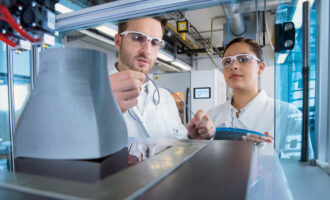Wanted: new test methods for greases
A new working group on grease has been formed within the International Organization for Standardization (ISO), an independent, non governmental membership organisation based in Geneva, Switzerland. ISO is the world’s largest developer of voluntary international standards. The group is called WG/ TC28/WG19, Development of Test Methods for Greases, and Josef Barreto-Pohlen is the official convener.
Barreto-Pohlen, technical manager, greases, EMEA, at Quaker Chemical B.V., Uithoorn, The Netherlands, spoke about his plans for the group.
The working group’s goal is to develop, initiate and define “state-of-theart ISO test standards to describe and determine the properties of lubricating greases,” he said. ISO 12924, the current specification for the designation of greases, currently contains many test methods that are not ISO standards, he added. The group’s plan is for this specification to use ISO test methods in the future.
At the first meeting of this working group in Berlin, Germany in June, the group discussed which tests it would like to see added to ISO 12924. Tests that already exist within ISO, Barreto-Pohlen explained, do not need to be revised because they already belong to their own working groups; however, “there are several other tests for which we will do ballots in the near future for the participating countries to decide whether we make them ISO standards or not.”
The standards that will be the focus of the working group aim to clarify both grease properties, such as penetration, consistency and drop point, and performance. These properties must be tested in every production batch because “we are dealing with technical raw materials, and since they are from natural resources, plants, they vary from harvest to harvest. Or it depends on where they were grown.” Performance tests, on the other hand, are longer and take more resources. For example, determining the lifespan of a grease involves letting a greased wheel bearing run until it fails.
The group would like to update ISO/NP18224, the dropping point for lubricating greases using an automatic apparatus. Currently, there is only a test for the manual dropping point, which is a time-consuming test. Furthermore, Barreto- Pohlen said, most facilities work with automatic apparatus, but no official standard exists for it, so “it is important that we have this as a work item proposal.”
Additionally, ISO/ NP18503, Testing of Lubricants – determination of shear viscosity of lubricating greases by a rotation viscometer, needs to be reactivated, he said.

Other tests exist within some countries’ national standards but not within ISO, so the working group is considering bringing some of these into ISO. Some of these include the copper corrosion test, which both the European Lubricating Grease Institute (ELGI)\ and U.S.-based National Lubricating Grease Institute (NLGI) has\ run extensively, as well as elemental analysis of greases and oil separation. There is also the FE9 Lifetime Test, DIN 51821, Testing of Lubricants; Test Using FAG Roller Bearing Grease Testing Apparatus FE9. DIN is the German national standardisation body. ASTM International, based in West Conshohocken, Penn.,U.S.A., also has ASTM D 3336, Standard Test Method for Life of Lubricating Greases in Ball Bearings at Elevated Temperatures. It remains to be seen, however, if there are plans within ASTM to propose it as a new work item for ISO. Barreto-Pohlen agreed that having harmonised standards, instead of having different versions of a similar method in different countries, is a worthy goal.
For national standards to\ be discussed in the group, an English translation needs to be provided. Barreto-Pohlen has requested that the working group inside DIN provide an English translation of the FE9 Lifetime Test, which will be sent out to members of the ISO working group.
Trends in the grease industry
Standards have to change along with industry trends. For decades, there has been a trend toward fill-for-life applications, and this is still the case, said Barreto-Pohlen. However, this will be a slow process, because there are still plenty of machines running in the industry (especially heavy industry like steel mills) requiring loss lubrication, and it would be too costly to replace the machinery before its time is up.
Synthetic greases are also a topic of conversation, but the market has yet to show a serious need for them, since for years their share has been stable at between 8-10% worldwide, he said. Synthetics can have an advantage in extreme conditions, but “most applications are running in moderate conditions, well below 100° C. At those temperatures, mineral oil very often works just fine.” Additionally, synthetics are usually more costly than mineral oil-based greases, so the customer has to be made aware of their advantages over conventional products, he said.
Barreto-Pohlen said that customers now prefer specialised greases, regardless of their base fluid, over general-use greases, as well.
When deciding which test method to use, it often comes down to cost. That is why the working group plans to propose alternative test methods, said Barreto-Pohlen. Changes do not happen quickly, but the need has certainly been recognised o offer alternatives to the current tests. Developing test methods is a costly endeavor, so options are often very few.
ISO is not the only organisation, however, that recognises the need to update many of the current test methods for greases. At the NLGI Annual meeting in Coeur d’Alene, Idaho, U.S.A. in June, Gareth Fish, strategic technology manager at Lubrizol Additives, discussed obsolete test methods and the challenges in updating them. Fish helped write the latest edition of SAE J310, the Standard Classification and Specification for Service Greases. SAE J310 contains 12 test methods, and according to Fish, about half of them need major updates and/or replacement. SAE J310 was last revised in 2005. Some of the test methods ncall for technology that is no longer safe to use, such as a mercury and glass thermometer, or hardware from the 1970s that is hardly used today. What’s really necessary in many cases, Fish said, is for some standards to be retired and new ones to take their place.
He also pointed out that SAE J310 is missing tests for access sealant, oxidation and copper corrosion. Many manufacturers, however, are reluctant to use a new specification because their current manuals specify SAE J310. But, Fish said some automotive grease applications, like bearing and chassis lubrication, are fill-for-life applications, so the impact to the customer would be relatively low.
So far, nine countries have indicated interest in contributing talent to the ISO working group. At the first meeting, though,only representatives from Germany and China were present. Barreto-Pohlen said that the group plans to conduct its next meeting via the Internet so people from other countries can participate.
Future work items include investigating the determination of water content, elemental analysis, infrared spectroscopy and copper corrosion. The test methods that the industry relies on need to be on par with the modern-day grease industry, without being costly, Barreto- Pohlen said. This, he added, is one of the group’s biggest challenges.









